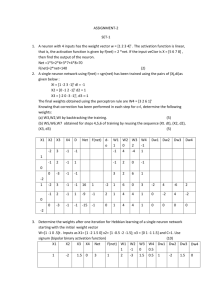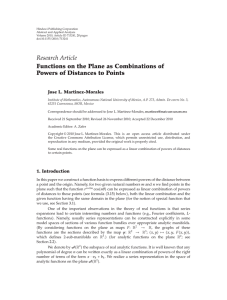A GENERALIZED MAXIMUM PRINCIPLE FOR BOUNDARY WITH DISCONTINUOUS COEFFICIENTS
advertisement
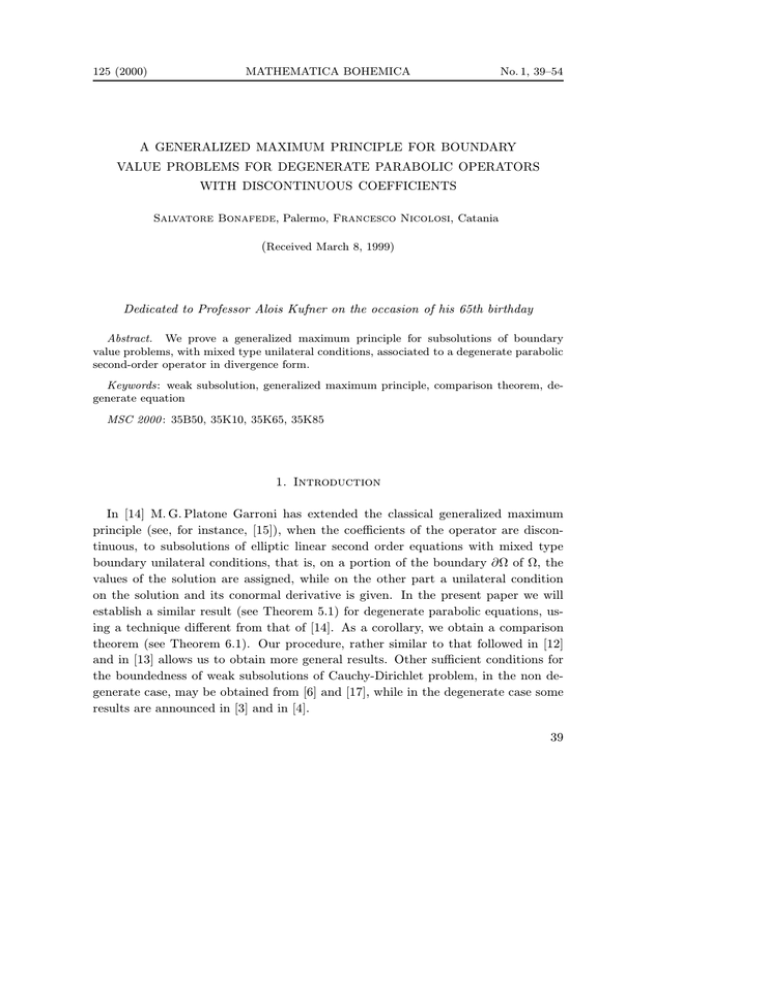
125 (2000)
MATHEMATICA BOHEMICA
No. 1, 39–54
A GENERALIZED MAXIMUM PRINCIPLE FOR BOUNDARY
VALUE PROBLEMS FOR DEGENERATE PARABOLIC OPERATORS
WITH DISCONTINUOUS COEFFICIENTS
Salvatore Bonafede, Palermo, Francesco Nicolosi, Catania
(Received March 8, 1999)
Dedicated to Professor Alois Kufner on the occasion of his 65th birthday
Abstract. We prove a generalized maximum principle for subsolutions of boundary
value problems, with mixed type unilateral conditions, associated to a degenerate parabolic
second-order operator in divergence form.
Keywords: weak subsolution, generalized maximum principle, comparison theorem, degenerate equation
MSC 2000 : 35B50, 35K10, 35K65, 35K85
1. Introduction
In [14] M. G. Platone Garroni has extended the classical generalized maximum
principle (see, for instance, [15]), when the coefficients of the operator are discontinuous, to subsolutions of elliptic linear second order equations with mixed type
boundary unilateral conditions, that is, on a portion of the boundary ∂Ω of Ω, the
values of the solution are assigned, while on the other part a unilateral condition
on the solution and its conormal derivative is given. In the present paper we will
establish a similar result (see Theorem 5.1) for degenerate parabolic equations, using a technique different from that of [14]. As a corollary, we obtain a comparison
theorem (see Theorem 6.1). Our procedure, rather similar to that followed in [12]
and in [13] allows us to obtain more general results. Other sufficient conditions for
the boundedness of weak subsolutions of Cauchy-Dirichlet problem, in the non degenerate case, may be obtained from [6] and [17], while in the degenerate case some
results are announced in [3] and in [4].
39
2. Functional spaces
Let Êm be the Euclidean space (m > 2) with a generic point x = (x1 , x2 , . . . , xm ),
Ω a bounded open subset of Êm whose boundary satisfies locally a Lipschitz condition,
T a real positive number. Let us denote by Q(τ1 , τ2 ) (0 τ1 < τ2 T ) the
cylinder Ω×]τ1 , τ2 [ and let Q = Q(0, T ); Γ is the parabolic boundary of Q, that is
Γ = Ω × {t = 0} ∪ ∂Ω×]0, T [ .
Let ∂Ω2 be a closed subset of ∂Ω, Γ2 = ∂Ω2 ×[0, T ], and let us set ∂Ω1 = ∂Ω\∂Ω2,
Γ1 = ∂Ω1 × [0, T ].
The symbol measx will henceforth denote the m-dimensional measure.
If u(x) is a measurable function defined in Ω, we will denote by |u|p (1 p ∞)
the usual norm in the space Lp (Ω).
2.1. Let ν(x) be a positive function defined in Ω such that
ν(x) ∈ L
g(m−1)
g−m
(Ω),
ν −1 (x) ∈ Lg (Ω), g > m.
1 (ν, Ω) stands for the completion of C 1 Ω with respect to the norm
The symbol H
u1 =
|u|22
m
∂u 2 12
+
ν
;
∂x
i 2
i=1
C ∗ (Ω) denotes the following linear subspace of C ∞ Ω :
C ∗ (Ω) = u ∈ C ∞ Ω : u = 0 on ∂Ω2 .
1 (ν, Ω).
H ∗ (ν, Ω) denotes the closure of C ∗ (Ω) in H
If u(x, t) is a measurable real function in Q, we will denote by |u|p,q (1 p,
q +∞) the usual norm in the space Lp,q (Q), with the obvious modification if p or
q are +∞.
2.2. Let ψ(t) be a positive monotone nondecreasing function defined in ]0, T [ such that
ψ(t) ∈ L1 (0, T ).
1,0 νψ, Q(τ1 , τ2 ) (0 τ1 < τ2 T ) stands for the completion of
The symbol H
C 1 Q(τ1 , τ2 ) with respect to the norm
12
m
∂u 2 2
|u| +
νψ dx dt ;
∂xi
Q(τ1 ,τ2 )
i=1
u1,0,(τ1,τ2 ) =
u1,0 = u1,0,(0,T ).
40
1,0 νψ, Q(τ1 , τ2 ) is a Hilbert space with respect to the norm u1,0,(τ ,τ ) .
– H
1 2
– C ∗ Q(τ1 , τ2 ) (0 τ1 < τ2 T ) denotes the following linear subspace of
C ∞ Q(τ1 , τ2 ) ∩ C 0 Q(τ1 , τ2 ) :
– C ∗ Q(τ1 , τ2 ) = u ∈ C ∞ Q(τ1 , τ2 ) ∩ C 0 Q(τ1 , τ2 ) : u = 0 on ∂Ω2 × [τ1 , τ2 ] .
1,0
νψ, Q(τ1 , τ2 ) (0 τ1 < τ2 T ) is the closure of C ∗ Q(τ1 , τ2 ) in
– H
∗
1,0 νψ, Q(τ1 , τ2 ) .
H
Finally, we will denote by V 1,0 (νψ, Q) the space of functions u(x, t) belonging to
1,0
H (νψ, Q), continuous in [0, T ] with values in L2 (Ω).1
1,0 (νψ, Q τ1 , τ2 ) (0 τ1 <
Definition 1.
Given a real number h, if u ∈ H
τ2 T ), we will say that u(x, t) h ( h) on ∂Ωi × [τ1 , τ2 ] (i = 1, 2) if there exists
a sequence {un } of functions from C 1 Q(τ1 , τ2 ) such that
un (x, t) h ( h) on ∂Ωi × [τ1 , τ2 ]
and
lim un − u1,0,(τ1 ,τ2 ) = 0.
(∗)
n→∞
If k is such that u(x, t) k on ∂Ωi × [τ1 , τ2 ], we will say that u(x, t) is bounded from
above on ∂Ωi × [τ1 , τ2 ].
1,0 νψ, Q(τ1 , τ2 ) (0 τ1 < τ2 T )
Definition 2. If u(x, t), w(x, t) belong to H
and w(x, t) 0 on ∂Ωi × [τ1 , τ2 ] (i = 1, 2), let us denote2
sup∗
u
= inf h ∈ Ê : u(x, t) − hw(x, t) 0 on ∂Ωi × [τ1 , τ2 ] .
w
We will consider the following generalized problem:
(2.1)
where
m
m
m
∂ ∂u
∂u
∂u
−
=0
aij
+ di u +
bi
+ cu +
∂x
∂x
∂x
∂t
i j=1
j
i
i=1
i=1
in Q
m
∂u
+ αu +
di u cos nxi 0
∂ν
i=1
on Γ1 ,
m
∂u
∂u
=
aij cos nxj
,
∂ν
∂xi
i,j=1
and cos nxj is the j-th directional cosine of x, normal to Γ1 and external to Q.
1
2
For more details concerning hypotheses (2.1), (2.2) see also [5], [7], [8] and [9].
We suppose that inf ∅ = +∞.
41
By an LΓ1 -subsolution (LΓ1 -supersolution) of problem (2.1) we mean any function
u ∈ V 1,0 (νψ, Q) satisfying the following conditions:
m
m
∂u ∂ϕ ∂u
(2.2)
ã(u, ϕ) =
aij
+
bi
ϕ + cuϕ
∂xj ∂xi i=1 ∂xi
Q i,j=1
m
∂ϕ
∂ϕ
di u
−u
αuϕ dσ dt 0 ( 0)
+
dx dt +
∂xi
∂t
Γ1
i=1
for any ϕ ∈ C ∗ (Q) such that ϕ(x, t) 0 a.e. in Q, ϕ(x, 0) = ϕ(x, T ) = 0 for
a.e. x ∈ Ω.
Of particular interest are LΓ1 -subsolutions (LΓ1 -supersolutions) such that
m
m
m
∂u ∂ϕ ∂u
∂ϕ
∂ϕ
aij
+
bi
ϕ + cuϕ +
di u
−u
(2.3)
dx dt
∂xj ∂xi i=1 ∂xi
∂xi
∂t
Q i,j=1
i=1
αuϕ dσ dt 0 ( 0)
+
Γ1
∗
for any ϕ ∈ C (Q), ϕ(x, t) 0 on Γ1 , ϕ(x, 0) = ϕ(x, T ) = 0 for a.e. x ∈ Ω.
In fact, problem (2.3) is equivalent, at least “formally,” to the problem
m
m
m ∂
∂u
∂u
∂u
= 0 in Q
−
a
+
d
u
+
b
+
cu
+
ij
i
i
∂xi
∂xj
∂xi
∂t
i=1
j=1
i=1
m
∂u + αu +
di u cos nxi 0 ( 0)
∂ν
i=1
on Γ1 .
Let us consider the problem
m
m
m
∂u ∂ϕ
∂ϕ
∂ϕ
∂u
aij
+
bi
ϕ + cuϕ +
di u
−u
dx dt
∂xj ∂xi i=1 ∂xi
∂xi
∂t
i=1
Q i,j=1
αuϕ dσ dt =
f ϕ dx dt +
g1 ϕ dσ dt
+
Γ1
Q
Γ1
(2.4)
for any ϕ ∈ C ∗ (Q), ϕ(x, T ) = 0 in Ω
1,0 (νψ, Q)
u(x, t) − g2 (x, t) ∈ H
∗
u(x, 0) = 0 in Ω.
The problem (2.4) is formally equivalent to the problem
m
m
m ∂
∂u
∂u
∂u
−
=f
a
+
d
u
+
b
+
cu
+
i
i
i=1 ∂xi j=1 ij ∂xj
∂x
∂t
i
i=1
m
∂u
+ αu +
di u cos nxi = g1
∂ν
i=1
u = g2
u(x, 0) = 0
42
in Q
on Γ1
on Γ2
in Ω.
3. Hypotheses on coefficients
Let us denote by A the set of pairs (α∗, α) with 2 α∗, α +∞, such that there
exists a positive constant β for which
uα∗,α β u2,∞ + u1,0
(3.1)
1,0 (νψ, Q). The set A obviously contains3 the pair (2, +∞).
for any u ∈ L2,∞ (Q) ∩ H
Let us observe that, under the hypotheses on Ω, we have4
|u|
(3.2)
2(m−1)
m−2+ m
g
,∂Ω1
γu1
1 (ν, Ω).
for any u ∈ H
Consequently, we obtain:
(3.3)
0
T
ψ(t) |u|22(m−1)
m−2+ m
g
12
,∂Ω1
dt
γ u2,∞ + ||u1,0
1,0 (νψ, Q).
for any u ∈ L2,∞ (Q) ∩ H
The constant in (3.2) and (3.3) depends on Ω1 .
3.1. The functions a
ij (x, t),
bi (x, t), c(x, t), di (x, t) (1 i, j m)
are defined and measurable in Q;
∗
∗
∗
aij
bi
di
∈ L∞ (Q), √
∈ Lp ,p (Q), c ∈ Lq ,q (Q), √
∈ Lr ,r (Q),
νψ
νψ
νψ
where
1
1
1
+ ∗ = ,
p∗
α1
2
2
1
+
= 1,
q
α2
1
1
1
+
= ,
p α1
2
1
1
1
+ ∗ = ,
∗
r
α3
2
1
2
+ ∗ = 1,
q∗
α2
1
1
1
+
=
r
α3
2
with (α∗1 , α1 ), (α∗2 , α2 ) and (α∗3 , α3 ) belonging to A.
Moreover, if p = +∞ [q = +∞, r = +∞] and p∗ < +∞ [q ∗ < +∞, r∗ < +∞],
then there exists a function η1 (σ) [η2 (σ), η3 (σ)], defined for σ 0, non decreasing,
∈ Lt (0, T ) (0 < t +∞), the set A contains the pair
t
any θ ∈ 0, t+1
, see, for instance, [13].
4
See, for instance, [11] Theorem 3.9.
3
If
1
ψ(t)
2mg
2t
mg+mθ−2θg , θ(t+1)
for
43
vanishing for σ approaching zero and satisfying for almost all t in the interval ]0, T [
the inequalities
p∗ p1
m |bi (x, t)|
dx
η1 σ ψ(t),
ν(x)
E
i=1
1
q
q ∗
|c(x, t)| − c(x, t) dx
η2 σ ,
E
r∗ 1
m r
|di (x, t)|
dx
η3 σ ψ(t)
ν(x)
E
i=1
for all measurable subsets E of Ω such that measx E σ.
The function α(x, t) is defined and measurable on Γ1 and
m−1
α
m ∈ L∞ 0, T ; L 1− g ∂Ω1 .
ψ
3.2.
The functions f (x, t), g(x, t) are defined and measurable
respectively in Q and in Γ1 , moreover
f ∈ L2 (Q),
2(m−1)
g1
m √ ∈ L2 0, T ; L m− g ∂Ω1 .
ψ
The function g2 (x, t) is defined and measurable in Q and
1,0 (νψ, Q),
g2 ∈ H
∂g2
∈ L2 (Q),
∂t
g2 (x, t) 0 on Γ1 .
Finally, the functions f ∗ (x, t), g1∗ (x, t) are defined and measurable respectively in
Q and in Γ1 , moreover
f ∗ ∈ L2 (Q),
2(m−1)
g∗
m √1 ∈ L2 0, T ; L m− g ∂Ω1 .
ψ
3.3. The following inequality holds for a.e. (x, t) in Q and for all
real numbers χ1 , χ2 , . . . , χm :
m
i,j=1
44
aij (x, t)χi χj ν(x)ψ(t)
m
i=1
χ2i .
4. Preliminary lemmas
Lemma 4.1. Let us assume that hypotheses (2.1), (2.2), (3.1) hold and let u(x, t)
be an LΓ1 -subsolution of the problem (2.1) bounded from above on ∂Ω2 ×[0, T ]. Then
if 0 τ̃1 < τ < T and k > sup∗ u, we get
Q(τ̃1 ,τ )
m
m
m
∂v ∂v
∂v
∂v
+
bi
v + cuv +
di u
dx dt
∂xj ∂xi i=1 ∂xi
∂xi
i,j=1
i=1
τ
1
1
v 2 (x, τ ) dx +
αuv dσ dt v 2 (x, τ̃1 ) dx,
+
2 Ω
2
τ̃1 ∂Ω1
Ω
aij
5
1,0
where v = u − min(u, k) in Q; moreover, v ∈ H
∗ (νψ, Q).
.
Let τ̃1 , τ be such that 0 < τ̃1 < τ < T ; setting τ1 = τ +T
2 , τ2 = T − τ1 ,
we denote by Cτ∞ (Q) the set of nonnegative functions from C ∗ (Q) equal to zero for
t τ1 . Let ϕ be a function from Cτ∞ (Q). We extend u, ϕ and the coefficients of
(2.1) to Ω × (−∞, +∞), assuming that these functions are equal at zero in those
points where they are not defined.
We define in Ω × ]−∞, +∞[ and for any integer :
Φ (x, t) =
τ2
U (x, t) =
τ2
B (x, t) =
τ2
C (x, t) =
τ2
Ai, (x, t) =
τ2
Di, (x, t) =
τ2
α (x, t) =
τ2
5
t
ϕ(x, λ) dλ,
τ2
τ
t+ 2
t−
u(x, λ) dλ,
t
t+
τ2
t
m
i=1
t+
bi (x, λ)
∂u(x, λ)
dλ,
∂xi
τ2
c(x, λ)u(x, λ) dλ,
t
t+
τ2
t
j=1
t+
aij (x, λ)
∂u(x, λ)
dλ,
∂xj
τ2
di (x, λ)u(x, λ) dλ,
t
m
t+
τ2
α(x, λ)u(x, λ) dλ.
t
Let us observe that, for t a.e. in ]0, T [, v(x, t) ∈ H ∗ (ν, Ω).
45
From (2.2), in virtue of ϕ = Φ (x, t), via an exchange of the order of integration
with respect to t and λ,6 we get
(4.1)
m
Q
i=1
Ai,
m
∂U
∂ϕ
∂ϕ
+ B ϕ + C ϕ +
Di,
+
ϕ dx dt
∂xi
∂xi
∂t
i=1
+
α ϕ dσ dt 0
Γ1
for all ϕ belonging to the functional class Cτ∞ (Q).
Let {un } be a sequence of functions of C 1 Q such that un < sup∗ u on Γ2 and
satisfying (∗). For all pairs of positive integers ν and n, we define
U,n (x, t) =
τ2
t
t+
τ2
un (x, λ) dλ;
the function U,n (x, t) belongs to C 1 Q(0, τ1 ) .
Let us now introduce the function7
U,n − min(U,n , k) in Q(τ̃1 , τ ),
V,n =
0
in Q \ Q(τ̃1 , τ ).
Let {Φµ }µ∈ be a sequence of nonnegative equibounded functions from Cτ∞ (Q)
1,0 νψ, Q(τ̃1 , τ ) ;8 moreover, let also the functions in the
converging to V,n in H
∂Φ sequence ∂xµi µ∈ be equibounded.
From (4.1), in virtue of ϕ = Φµ (x, t), as µ diverges to +∞, we obtain the following
relation:
(4.2)
m
m
∂V,n
∂V,n
∂U
V,n dx dt
Ai,
+ B V,n + C V,n +
Di,
+
∂xi
∂xi
∂t
Q(τ̃1 ,τ ) i=1
i=1
τ
αν V,n dσ dt 0.
+
τ̃1
∂Ω1
Setting now in Q:
V =
6
U − min(U , k) in Q(τ̃1 , τ ),
0
in Q \ Q(τ̃1 , τ );
See [10], p. 141.
Since k > sup∗ u there exists a neighbourhood of ∂Ω2 such that V,n (x, t) = 0 for any
t ∈]0, T [ (see Lemma 4.2 of [3]).
8
See remark 4.1 of [3].
7
46
1,0 νψ, Q(τ̃1 , τ ) ∩ L2,∞ Q(τ̃1 , τ ) and satthe sequence {V,n } converges to V in H
isfies the relation
lim (V,n − V ) 2(m−1)m ,2,Γ = 0.
n→∞
m−2+
1
g
1,0
νψ, Q(τ̃1 , τ )
On the other hand, the functions of the sequence {V,n } belong to H
∗
and so also V belongs to this space.
From (3.1)–(3.6) we deduce, as n goes to +∞, the following inequality:9
m
(4.3)
Q
i=1
m
∂U
∂V
∂V
V,n dx dt
+ B V + C V +
Di,
+
∂xi
∂xi
∂t
i=1
1
U (x, τ ) − k 2 dx
+
2 Ω (τ,k)
τ
1
U (x, 0) − k 2 dx +
−
α V dσ dt 0.
2 Ω (0,k)
τ̃1 ∂Ω1
Ai,
1,0 (νψ, Q) ∩ L2,∞ (Q) to the
Let us remark that the sequence {V } converges in H
function equal to v in Q(τ̃1 , τ ) and equal to zero in Q \ Q(τ̃1 , τ ).
From (4.3), the conclusion follows via another passage to the limit.
For example, we prove that
τ
τ
lim
n→∞
τ̃1
∂Ω1
α V dσ dt =
αuv dσ dt.
τ̃1
∂Ω1
We get
τ τ̃1
α V − αuv dσ dt
∂Ω1
ψ(τ ) α
γ
u2,∞ + u1,0
m−1
ψ(τ̃1 ) ψ 1− m ,∞,Γ1
g
× V − v2,∞,(τ̃1 ,τ ) + V − v1,0,(τ̃1 ,τ ) +
1 12
ψ(τ̃1 )
m
12
τ g
m−
2(m−1)
m−1
m− m
g
α − αu
× v2,∞,(τ̃1 ,τ ) + v1,0,(τ̃1 ,τ )
dσ
dt
τ̃1
for any ∈ Æ .10
9
10
For a fixed t ∈]0, T [, we set Ω (t, k) = {x ∈ Ω : U (x, t) > k}.
Let us remark that, by the properties of Steklov averages, it follows that α converges
2(m−1)
m− m
g (∂Ω ) .
to αu in L2 τ̃1 , τ ; L
1
47
Next, it is easy to verify that the restriction of the function v to Q(τ̃1 , τ ) belongs
1,0
to H
(νψ, Q) for any 0 < τ̃1 < τ < T and, therefore, since v by definition belongs to
∗
1,0
1,0
H
νψ, Q(τ̃1 , τ ) , it belongs to H
∗ (νψ, Q), too.
τ
Finally, if τ̃1 = 0, as τ > 0 is assumed, it suffices to consider τn = n+1
for n ∈ Æ
recalling that the function v(x, t) is continuous in [0, T ] with values in L2 (Ω).
Lemma 4.2. Let us assume the hypotheses (2.1), (2.2), (3.1), (3.3) hold and let
u(x, t) be an LΓ1 -subsolution of the problem (2.1) satisfying the conditions
ess sup u(x, 0) 0,
Ω
sup∗ u 0.
Then, we have:
ess sup u(x, t) 0.
Q
.
For any integer n, we consider the functions
1
v = u − min(u, 0), vn = u − min u,
.
n
1,0
From Lemma 4.1 we deduce that vn belongs to H
∗ (νψ, Q) and that, provided
τ ∈]0, T [, we have
m
(4.4)
Q(τ )
m
m
∂vn ∂vn ∂vn
∂vn
aij
+
bi
vn + cuvn +
di u
dx dt
∂xj ∂xi
∂xi
∂xi
i,j=1
i=1
i=1
τ
1
2
v (x, τ ) dx +
αuvn dσ dt 0.
+
2 Ω n
0
∂Ω1
On the other hand, we obtain
lim vn (x, t) = v(x, t),
n→∞
|vn (x, t)| |u(x, t)| in Q
and
∂v ∂u ∂vn
∂v
n =
, a.e. in Q.
n→∞ ∂xi
∂xi
∂xi
∂xi
1,0
Furthermore, also v belongs to H
∗ (νψ, Q) and so, as n goes to +∞ in (4.4),
we get
m
m
m
∂v ∂v
∂v
∂v
2
(4.5)
aij
+
bi
v + cv +
di v
dx dt
∂xj ∂xi i=1 ∂xi
∂xi
Q(τ ) i,j=1
i=1
τ
1
2
v (x, τ ) dx +
αv 2 dσ dt 0.
+
2 Ω
0
∂Ω1
lim
From (4.5) we deduce that |v|2,∞ = 0 and the conclusion easily follows.
48
The proof is similar to that given in Lemma 4.1 of [13]; let us remark that since
1,0 (νψ, Q) ∩ L2,∞ (Q) we can apply the relations (3.1) and (3.3) instead of the
v∈H
hypothesis A) of [13].
5. A generalized maximum principle
We will prove
Theorem 5.1. Let us assume the hypotheses (2.1), (2.2), (3.1), (3.3) hold and
let w(x, t) be an LΓ1 -supersolution of the problem (2.1) satisfying the conditions
w(x, t) > 0 a.e. in Q,
w(x, 0) > 0 a.e. in Ω,
Then
(5.1)
ess sup
Q
w(x, t) 0 on Γ2 .
u(x, t)
u(x, 0)
u
max 0, ess sup
, sup∗
w(x, t)
w(x, 0)
w
Ω
for any LΓ1 -subsolution u(x, t) of the problem (2.1).
. The conclusion is obvious if the second term of (5.1) is equal to +∞.
Let us suppose, now, that this term is finite and let us denote by h some real number
greater than its value. Consequently, the function u(x, t)−hw(x, t) is an LΓ1 -subsolu
tion of the problem (2.1) such that ess supΩ u(x, 0)−hw(x, 0) 0, sup∗ (u−hw) 0.
From Lemma 4.2 we can see that u(x, t) − hw(x, t) 0 a.e. in Q. So, we obtain
u(x,t)
ess supQ w(x,t)
h and the conclusion easily follows.
6. A comparison theorem
Let us define the following closed convex sets:
1,0 (νψ, Q), z ∈ C [0, T ]; L2(Ω) , z(x, 0) = 0, z g2 on Γ2 ,
K∗ = z ∈ H
1,0 (νψ, Q), ∂ϕ ∈ L2 (Q), ϕ(x, T ) = 0, ϕ g2 on Γ2
Φ∗ = ϕ ∈ H
∂t
and let us suppose that there exists a solution z ∈ K ∗ of the variational inequality
m
m
∂z ∂(ϕ − z) ∂z
aij
+
bi
(ϕ − z) + cz(ϕ − z)
(6.1)
∂xj ∂xi
∂xi
Q i,j=1
i=1
m
∂(ϕ − z)
∂ϕ
di z
−z
αz(ϕ − z) dσ dt
+
dx dt +
∂xi
∂t
Γ1
i=1
f ∗ (ϕ − z) dx dt +
g1∗ (ϕ − z) dσ dt
Q
Γ1
49
for any ϕ ∈ Φ∗. The problem (6.1) is formally equivalent to the problem
m
m
m
∂ ∂z
∂z
∂z
−
= f∗
a
+
d
z
+
b
+
cz
+
ij
i
i
∂x
∂x
∂x
∂t
i
j
i
j=1
i=1
i=1
m
∂z
+ αz +
di z cos nxi = g1∗
∂ν
i=1
m
m
∂z ∂z
+
+
z
g
,
d
z
cos
nx
0,
(z
−
g
)
d
z
cos
nx
=0
2
i
i
2
i
i
∂ν i=1
∂ν i=1
z(x, 0) = 0
in Q
on Γ1
on Γ2
in Ω.
We will prove
Theorem 6.1. Let us assume the hypotheses (2.1), (2.2), (3.1), (3.2), (3.3) hold
and let w(x, t) be an LΓ1 -supersolution of the problem (2.1) satisfying the conditions
w(x, t) > 0 a.e. in Q,
w(x, t) 0 on Γ2 .
w(x, 0) > 0 a.e. in Ω,
Let z(x, t) be a solution of the problem (6.1) with f ∗ f in Q, g1∗ g1 on Γ1 .
Then, we have the inequality
u(x, t) z(x, t) a.e. in Q
for any solution u(x, t) of the problem (2.4).
.
Let us extend z(x, t) to Êm+1 assuming that it vanishes at points not
belonging to Q; for a fixed τ ∈ ]0, T [ and for any pairs of integers , n we introduce
the functions
0
θn (t) = n t +
1
2
n
−τ
zn, (x, t) = θn (t)
50
if t < τ − n2 ,
if τ −
2
n
t τ − n1 ,
if t > τ − n1 ;
1
t+ 2
1
t− 2
z(x, y)θn (y) dy.
We have
∂zn,
= θn (t)
∂t
1
t+ 2
1
t− 2
z(x, y)θn (y) dy
1
1
1 1 θn t +
− z x, t −
θn t −
+ θn (t) z x, t +
.
2
2
2
2
Choosing ϕ = zn, + β, 0 β ∈ C ∗ (Q), β(x, t) = 0 a.e. in Q, we get from (6.1)
m
m
∂z ∂(zn, + β − z) ∂z
(6.2)
aij
+
bi
(zn, + β − z)
∂xj
∂xi
∂xi
Q i,j=1
i=1
m
∂(zn, + β − z)
di z
+ cz(zn, + β − z) +
dx dt
∂xi
i=1
∂zn,
∂β
dx dt −
dx dt +
z
z
αz(zn, + β − z) dσ dt
−
∂t
Q
Q ∂t
Γ1
f ∗ (zn, + β − z) dx dt +
g1∗ (zn, + β − z) dσ dt;
Q
Γ1
now, taking into account the relation
1 1
z x, t +
dx dt
z(x, t)θn (t)θn t +
2
2
Q
+∞
1 1
=
z x, t +
dt
dx
z(x, t)θn (t)θn t +
2
2
−∞
Ω
+∞ 1
1
θn t −
θn (t)z(x, t) dt
=
dx
z x, t −
2
2
−∞
Ω
1 1
=
z(x, t)θn (t)θn t −
z x, t −
dx dt,
2
2
Q
we obtain from (6.2)
m
m
∂z ∂(zn, + β − z) ∂z
aij
+
bi
(zn, + β − z)
∂xj
∂xi
∂xi
Q i,j=1
i=1
m
∂(zn, + β − z)
+ cz(zn, + β − z) +
di z
dx dt
∂xi
i=1
1
t+ 2
∂β
dx dt
−
z(x, y)θn (y) dy dx dt −
z
zθn (t)
1
Q
t− 2
Q ∂t
+
αz(zn, + β − z) dσ dt
Γ1
f ∗ (zn, + β − z) dx dt +
g1∗ (zn, + β − z) dσ dt,
Q
Γ1
51
and therefore, letting tend to +∞, we find that
(6.3)
m
m
∂z ∂(θn2 (t)z + β − z) ∂z 2
θn (t)z + β − z
+
bi
∂x
∂x
∂x
j
i
i
Q i,j=1
i=1
m
∂(θn2 (t)z + β − z)
di z
+ cz θn2 (t)z + β − z +
dx dt
∂xi
i=1
∂β
2
dx dt +
αz θn2 (t)z + β − z dσ dt
− z θn (t)θn (t) dx dt − z
Q
Q ∂t
Γ1
f ∗ θn2 (t)z + β − z dx dt +
g1∗ θn2 (t)z + β − z dσ dt.
aij
Q
Γ1
Let us observe that θn (t)θn (t) 0 a.e. in ]0, T [ and θn (t)θn (t) >
τ − n1 . Then, from (6.3) we have
m
n
2
3
if τ − 2n
<t<
m
∂z ∂(θn2 (t)z + β − z) ∂z 2
θn (t)z + β − z
+
bi
∂xj
∂xi
∂xi
Q i,j=1
i=1
m
2
∂(θn2 (t)z + β − z)
di z
+ cz θn (t)z + β − z +
dx dt
∂xi
i=1
∂β
dx dt +
−
z
αz θn2 (t)z + β − z dσ dt
Q ∂t
Γ1
2
z θn (t)θn (t) dx dt +
f ∗ θn2 (t)z + β − z dx dt
Q
Q
∗ 2
g1 θn (t)z + β − z dσ dt
+
n
2
aij
Γ1
1
τ−n
dt
3
τ − 2n
+
Γ1
z 2 (x, t) dx +
Ω
Q
f ∗ θn2 (t)z + β − z dx dt
g1∗ θn2 (t)z + β − z dσ dt.
Finally, as n → ∞ and τ → 0, we get
(6.4)
m
Q
m
Γ1
Q
for any 0 β ∈ C ∗ (Q), β(x, T ) = 0 a.e. in Q.
52
m
∂z
∂z ∂β
∂β
∂β
+
bi
β + czβ +
di z
−z
∂x
∂x
∂x
∂x
∂t
j
i
i
i
i,j=1
i=1
i=1
αzβ dσ dt f ∗ β dx dt +
g1∗ β dσ dt
+
aij
Γ1
dx dt
By virtue of (6.4) and (2.4) we conclude that
ã(u − z, ϕ) Q
f − f ∗ β dx dt +
Γ1
g1 − g1∗ β dσ dt 0
for any 0 β ∈ C ∗ (Q), β(x, T ) = 0 a.e. in Q.
Applying the above maximum principle to the LΓ1 -subsolution (u − z) and to the
LΓ1 -supersolution w, we obtain
ess sup
Q
u(x, t) − z(x, t)
u − z
max 0, sup∗
= 0.
w(x, t)
w
This completes the proof.
References
[1] Adams, R. A.: Sobolev Spaces. Academic Press, New York, 1975.
[2] Baiocchi, C.: Soluzioni deboli dei problemi ai limiti per le equazioni paraboliche del tipo
del calore. Ist. Lombardo Accad. Sci. Lett. Rend. Sez. A 103 (1969), 704–726.
[3] Bonafede, S.: On maximum principle for weak subsolutions of degenerate parabolic
linear equations. Comment. Math. Univ. Carolin. 35 (1994), 417–430.
[4] Bonafede, S.: A generalized maximum principle for weak subsolutions of degenerate
parabolic equations. Rend. Circ. Mat. Palermo (2) 41 (1992), 81–95.
[5] Drábek, P., Nicolosi, F.: Existence of bounded solutions for some degenerated quasilinear elliptic equations. Ann. Mat. Pura Appl. (4) 165 (1993), 217–238.
[6] Eklund, N. A.: Generalized super-solution of parabolic operators. Trans. Amer. Math.
Soc. 220 (1976), 235–242.
[7] Guglielmino, F., Nicolosi, F.: W -solutions of boundary value problems for degenerate
elliptic operators. Ricerche Mat. Suppl. 36 (1987), 59–72.
[8] Guglielmino, F., Nicolosi, F.: Existence theorems for boundary value problems associated with quasilinear elliptic equations. Ricerche Mat. 37 (1988), 157–176.
[9] Guglielmino, F., Nicolosi, F.: Existence results for boundary value problems for a class of
quasilinear parabolic equations. Actual problems in analysis and mathematical physics,
Proceeding of the international symposium in Taormina, Italy, 1992. Univ. di Roma,
Roma, 1993, pp. 95–117.
[10] Ladyzhenskaja, O. A., Solonnikov, V. A., Ural’tseva, N. N.: Linear and Quasi-Linear
Equations of Parabolic Type. Translation of mathematical monographs, vol. 23, A. M. S.
Providence, 1968.
[11] Murthy, M. K. V., Stampacchia, G.: Boundary value problems for some degenerateelliptic operators. Ann. Mat. Pura Appl. (4) 80 (1968), 1–122.
[12] Nicolosi, F.: Sottosoluzioni deboli delle equazioni paraboliche lineari del secondo ordine
superiormente limitate. Matematiche 28 (1973), 361–378.
[13] Nicolosi, F.: Soluzioni dei problemi al contorno per operatori parabolici che possono
degenerare. Ann. Mat. Pura Appl., IV. Ser. 125 (1980), 135–155.
[14] Platone Garroni, M. G.: A generalized maximum principle for boundary value problems
for elliptic operators with discontinuos coefficients. Boll. U. M. I. (4) 9 (1974), 1–9.
[15] Protter, M. H., Weinberger H. F.: Regular points for elliptic equations with discontinuous coefficients. Ann. Scuola Sup. Pisa 17 (1963), 45–79.
53
[16] Stampacchia, G.: Le probleme de Dirichlet pour les equations elliptiques du second
ordre a coefficients discontinus. Annal. Inst. Fourier 15 (1965), 187–257.
[17] Troianello, G. M.: On weak subsolutions for parabolic second-order operators. Comm.
Partial Differential Equations 3, 933–948.
Authors’ addresses: Salvatore Bonafede, Dipartimento di Economia dei Sistemi AgroForestali, University of Palermo, Viale delle Scienze, 90128 Palermo, Italy; Francesco
Nicolosi, Department of Mathematics, University of Catania, Viale A. Doria 6, 95125 Catania, Italy.
54



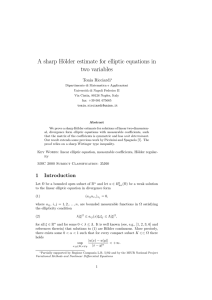
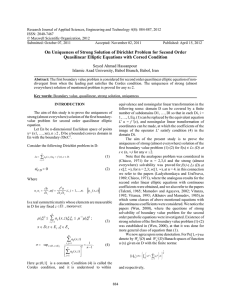


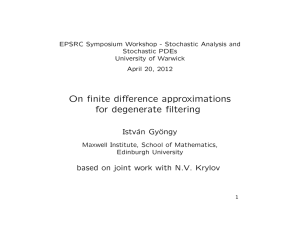

![5.5 The Haar basis is Unconditional in L [0, 1], 1 < 1](http://s2.studylib.net/store/data/010396305_1-450d5558097f626a0645448301e2bb4e-300x300.png)
